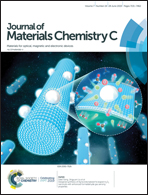Real-time colorimetric water content monitoring of organic solvents by an azo dye incorporated into AlPO4-5 nanochannel†
Abstract
Encapsulation of a functional organic dye in a rigid host is a viable approach to obtain a chemically stable water sensor. This study employed a H+-sensitive organic dye encapsulated in a zeolite, AlPO4-5, for the detection of atmospheric moisture and trace water in various organic solvents. AlPO4-5 not only acted as the host but also facilitated the dissociation of water molecules chemisorbed in its framework. The generated H+ protonated the encapsulated azo dye, resulting in a color change that could be clearly seen with the naked eye. The water content was determined from the ratiometric change in the optical absorption of the azo dye at ∼575 and ∼465 nm. A high sensitivity, broad detection range (0.1–5 wt%), fast response (within 5 s), and multiple reusability were achieved in the colorimetric monitoring of various alcohol and non-alcohol solvents. Importantly, we demonstrated that this method has high sensitivity and comparable accuracy to the traditional Karl Fisher method. Thus, our portable and reusable sensor design can be potentially adopted for convenient industrial process and environmental monitoring.



 Please wait while we load your content...
Please wait while we load your content...